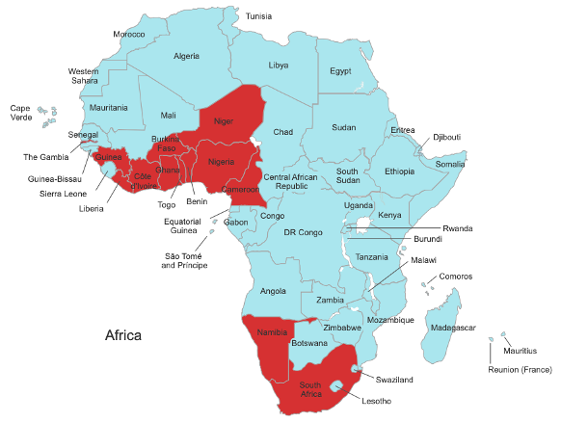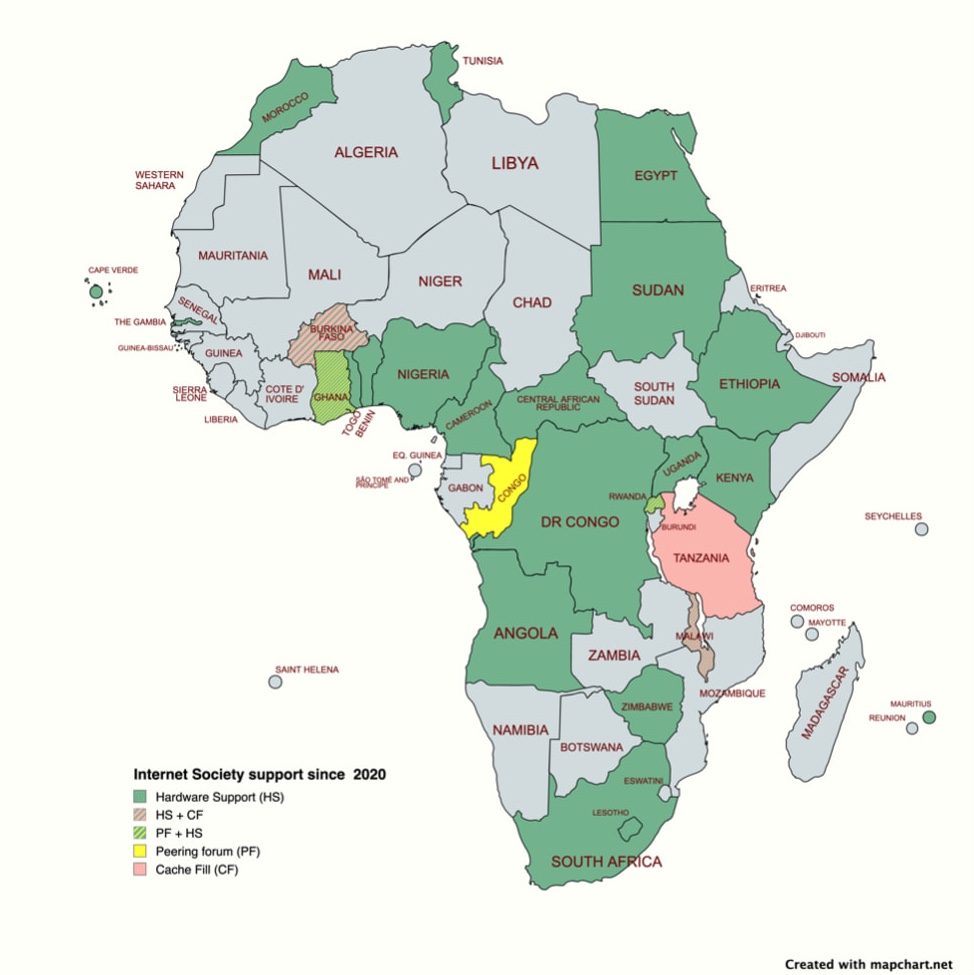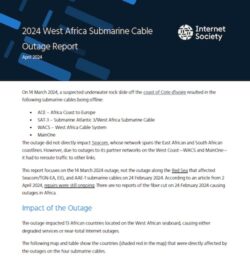On 14 March 2024, a suspected underwater rock slide off the coast of Cote d’Ivoire resulted in the following submarine cables being offline:
- ACE – Africa Coast to Europe
- SAT-3 – Submarine Atlantic 3/West Africa Submarine Cable
- WACS – West Africa Cable System
- MainOne
The outage did not directly impact Seacom, whose network spans the East African and South African coastlines. However, due to outages to its partner networks on the West Coast—WACS and MainOne—it had to reroute traffic to other links.
This report focuses on the 14 March 2024 outage, not the outage along the Red Sea that affected Seacom/TGN-EA, EIG, and AAE-1 submarine cables on 24 February 2024. According to an article from 2 April 2024, repairs were still ongoing. There are no reports of the fiber cut on 24 February 2024 causing outages in Africa.
Impact of the Outage
The outage impacted 13 African countries located on the West African seaboard, causing either degraded services or near-total Internet outages.
The following map and table show the countries (shaded red in the map) that were directly affected by the outages on the four submarine cables.

| Country | Connected to a Submarine Cable | Submarine and Terrestrial Cables | Number of Internet Exchange Points (IXPs) | Internet Resilience Index (IRI) Score |
|---|---|---|---|---|
| Benin | Yes | ACE, MTWA/MoovAfrica, SAT-3 | 1 | 42% |
| Burkina Faso | No | Terrestrial to Benin, Togo, Cote d’Ivoire, Niger, Mali, Ghana | 2 | 39% |
| Cameroon | Yes | WACS, SAT-3, SAIL, NCSCS | 2 | 32% |
| Cote d’Ivoire | Yes | ACE, MainOne, MTWA/MoovAfrica, SAT-3, WACS | 1 | 37% |
| Gambia | Yes | ACE | 1 | 35% |
| Ghana | Yes | MainOne, ACE, Glo-1, SAT-3, WACS | 2 | 34% |
| Guinea | Yes | ACE | 1 | 30% |
| Liberia | Yes | ACE | 1 | 32% |
| Namibia | Yes | Equiano, WACS | 1 | 40% |
| Niger | No | Terrestrial to Burkina Faso, Nigeria, Benin | 1 | 26% |
| Nigeria | Yes | MainOne, SAT-3, ACE, Glo-1, WACS, Equiano, NCSCS | 7 | 30% |
| South Africa | Yes | ACE, Equiano, SEACOM, WACS, SAT-3, SAFE, EASSy, METISS, T3 | 4 | 53% |
| Togo | Yes | WACS, Equiano, MTWA/MoovAfrica | 1 | 36% |
Analysis of the Outage
Countries with submarine cable diversity could maintain a level of uptime, indicating resiliency. Cross-border terrestrial fiber links were crucial in facilitating connectivity to operational submarine fiber cables for landlocked countries.
This map shows that all four affected submarine cables converge along the coast of Cote d’Ivoire, where the rockslide is reported to have happened. This can be deemed to be a single point of failure for the four cables.
It is unclear if other single points of failure exist in other countries where the cables converge or whether the cable operators have built-in protection in different areas along their cables. Submarine cable providers do not provide details about their cable routes for what is believed to be security reasons.
It should be noted that cable outages occur occasionally — usually affecting individual cables. Estimates are that there are about 100 fiber cuts a year. This incident is unique because multiple cables were damaged due to their convergence at a single physical point.
Google’s Equiano cable does not terminate in Cote d’Ivoire and was vital to maintaining uptime for several affected countries.
Maroc Telecom West Africa or MoovAfrica’s cable terminates in Cote d’Ivoire but was not affected by the rockslide and remained operational. This shows that they likely used a different path for their fiber cable, which helped Cote d’Ivoire maintain connectivity.
More submarine and terrestrial cables and diverse cable landing points are needed to help improve redundancy and resiliency across Africa.
Redundancy During the Outage
Several reports indicate that countries with access to Google’s Equiano cable and MTWA/MoovAfrica cables, unaffected by the reported rockslide, could maintain uptime during the outage.
Local operators used cross-border terrestrial fiber links in West Africa to reroute traffic to the Equiano cable, which saw a fourfold increase in traffic.
SEACOM South Africa also rerouted traffic to Google’s Equiano cable to provide traffic to networks that relied on its West African partner network via WACS and MainOne.
Microsoft reported outages of their services in the EMEA region on 14 March. Countries in Africa that were not directly affected by the submarine cable outage could not use services such as Microsoft Teams and Office365, among others. Microsoft services were restored later that day following a successful rerouting by Microsoft.
Niger, which still uses satellite connectivity, was able to maintain uptime over satellite and terrestrial fiber via Burkina Faso into Benin.
Cote d’Ivoire, the center of the outage, experienced a near-total Internet outage. The Moov Africa cable (also known as the Maroc Telecom West Africa or MTWA cable) remained operational and provided connectivity.
Repair Timelines
The cable operators of the affected submarine cables have provided the below estimates to restore services:
- SAT-3 from 29 March to 5 April (fully restored as of 6 April)
- ACE from 4 to 14 April
- WACS from 25 April to 5 May
- MainOne from 5 to 16 May
Internet Exchange Point (IXP) Traffic Summary during the Outage
As of publishing, information from affected countries shows that IXPs remained operational, meaning content available via IXPs has remained reachable.
Niger’s IXP is not operational at the moment. As mentioned, available terrestrial fiber and satellite connectivity are believed to have helped avoid the total outage of local and international traffic.
We will share more information about how the IXPs reacted to the incident as it comes to light.
Internet Society’s IXP Work in the Affected Countries
The Internet Society has carried out many activities to support the establishment and/or growth of IXPs in the countries affected by this fiber cut. These activities have included training workshops under the AXIS Project, equipment donations, cache fill grants, and hosting peering forums to strengthen the local IXP community.
Below is a summary of these activities and their respective impacts from the year 2011:
| Country | IXP Support | Outcomes and Impact |
|---|---|---|
| Benin | – IXP Best Practices Workshop in 2012 under the AXIS Project. – IXP Technical Workshop in 2013 under the AXIS Project. – Equipment donation and support to revamp the former existing Benin-IX in 2023, and the project is still in progress. | – Strengthening of the local IXP ecosystem. |
| Burkina Faso | – IXP Best Practices Workshop in 2012 under the AXIS Project. – IXP Technical Aspects Workshop in 2013 under the AXIS Project. – Internet Society IXP Workshop in 2019. – Internet Society cache fill grant program beneficiary. – Internet Society equipment donation to the IXP in 2022. | The cache-fill program led to: – 69% growth in number of networks connected. – 150% growth in number of IP prefixes at the IXP. – 600% growth in IXP traffic exchange. – USD 12.7M in estimated annual savings for ISPs under the cache fill grant. – Growth of cross-border interconnection between Burkina Faso and Lagos (Nigeria). – Lower IP Transit costs in Burkina Faso. – A new IXP is being established in Bobo Dioulasso (the second-largest city in Burkina Faso). |
| Cameroon | – IXP Best Practices Workshop in 2013 under the AXIS Project. – IXP Technical Aspects Workshop in 2014 under the AXIS Project – Equipment donation in 2023 to Douala-IX. | – Strengthening of the local IXP and peering ecosystem. |
| Cote d’Ivoire | – IXP Technical Aspects Workshop in 2013 under the AXIS Project. – Hosted AfPIF 2017. – Organizing the West African Peering Forum planned in Abidjan from 26–27 June 2024. | – Establishment of the Cote d’Ivoire IXP (CIVIX) under the AXIS Project. – CIVIX played an active role in hosting AfPIF 2017 and sends representatives to each AfPIF and AF-IX event. |
| Gambia | – IXP Best Practices Workshop in 2012 under the AXIS Project. – IXP Technical Aspects Workshop in 2013 under the AXIS Project. – Ethernet switch donation to Serrekunda IXP (SIXP) before 2020. | – Establishment of the Gambia IXP under the AXIS Project. – The SIXP implemented a local cache-fill initiative that resulted in significant traffic growth. |
| Ghana | – Organized AfPIF 2011 and 2023 – Ethernet switch donation to Ghana IX (GIX). | – Equipment donation allowed GIX to expand to multiple facilities in Accra at 1Gbps and 10Gbps. – Traffic in Ghana is now at 90Gbps, saving ISPs approximately USD 1.5M annually (Telegeography data USD 1.43/Mb/pm). – GIX played an active role in hosting AfPIF in 2011 and 2023. |
| Guinea | – IXP Best Practices Workshop in 2012 under the AXIS Project. – IXP Technical Aspects Workshop in 2013 under the AXIS Project. – The Internet Society Guinea Chapter has been actively promoting using the IXP. – In 2023, the Guinea Chapter and local Internet community successfully redelegated the .gn ccTLD to a local agency in Conakry and connected to the IXP. | – Establishment of the Guinea IXP under the AXIS Project. |
| Liberia | – IXP Best Practices Workshop in 2013 under the AXIS Project. – IXP Technical Aspects Workshop in 2014 under the AXIS Project. | – Establishment of the Liberia IXP under the AXIS Project. |
| Namibia | – IXP Best Practices Workshop in 2012 under the AXIS Project. – IXP Technical Aspects Workshop in 2013 under the AXIS Project. | – Establishment of the Namibia IXP under the AXIS Project. – Namibia has been an active member of Af-IX. |
| Niger | – IXP Best Practices Workshop in 2012 under the AXIS Project. – IXP Technical Aspects Workshop in 2013 under the AXIS Project. – Online IXP Workshop in 2022 and 2023. | – Strengthening of the local IXP ecosystem. |
| Nigeria | – Equipment donation to support the growth of IXPN. – Supported NgNOG and NgPIF events. – IXP Technical Aspects Workshop. | – Nigeria has a strong peering and interconnection community through the NgPIF. – IXPN is active in supporting AfPIF and AF-IX. – Nigeria was among the three countries in Africa to achieve 70% of local traffic exchanged by 2020. |
| South Africa | – Organized AfPIF 2012 and 2018. – Durban IXP ethernet switch donation in 2021. – Server and Optical module donations to INX-ZA in 2020. – Router donations to JINX, CINX, and DINX in 2020. – ZANOG cache fill support for Durban IXP (DINX). | – South Africa is home to NAPAfrica, one of the largest IXPs in the world. TERACO, the host organization for NAPAfrica, is a member of the Internet Society. – DINX/ZANOG Content Delivery Network (CDN) caching saves local Durban ISPs over $240,000 annually. – DINX added nine new networks during the 2-year cache fill grant period. – The three community IXPs in South Africa JINX, CINX, and DINX have increased multi-site resiliency. – Both INX-ZA and NAPAfrica are strong supporters of AfPIF through sponsorships. |
| Togo | – IXP Technical Aspects Workshop in 2013 under the AXIS Project. | – Togo-IX (TGIX) was the most expensive IXP in the region due to an equipment leasing agreement. – Optical module donations to Togo IXP in 2020 and 2021. – The peering equipment donation lowered the port cost charges for the connected networks. – Active at AfPIF events. |
The below map (Figure 2) shows the Internet Society’s IXP support activities in Africa from 2020. These have included:
- Hardware support (HS) — equipment donations to the IXP.
- Peering forums (PFs) — in-person events that bring together and strengthen the local IXP community.
- Cache fill (CF) grants — a grant support program that provides connectivity support to fill CDN caches hosted at IXPs.

Internet Society Chapter Updates and Responses
The following Internet Society Chapters shared various articles and updates on the outage:
- Ghana Chapter: One of the chapter members and Internet Society alumni published an article assessing the state of Internet resilience in Ghana and what needs improvement. The article was shared on the Internet and in a local newspaper.
- Togo Chapter: The chapter published a communique, and Radio France International interviewed the Chapter President. The Togo Chapter also shared an update on its website about the outage.
- Cameroon Chapter: The chapter joined the Cameroon IXP (CAMIX), Cameroon NOG (CAMNOG), and a coalition of local IT service providers and ISPs to publish a joint communique with recommendations to the Cameroon Government on actions to improve Cameroon’s Internet resilience. They used the data from Internet Society Pulse to support their recommendations.
- Somalia Chapter: The chapter issued a statement on the future of submarine fiber cables following the outage.
Internet Society in the Media
Internet Society staff members Jean-Baptiste Millogo and Dr. Dawit Bekele both gave their views on the outage as follows:
Dawit Bekele was interviewed by the French newspaper Jeune Afrique, which is widely read in Francophone Africa. The article provided public awareness of the Internet Society’s Internet measurement project, notably the Pulse Internet Resilience Index. It also discusses the importance of Internet resilience in avoiding the negative impacts of this kind of cable outage. It also denounces some myths, such as the one that says that government control of fiber cables increases Internet resilience.
Jean-Baptiste Millogo was interviewed on BF1 and RTB, two national TV stations in Burkina Faso with regional audiences. During both interviews, he discussed the importance of IXPs, restoration times for damaged submarine cables, how operators and Internet Service Providers (ISPs) provide services, the impact of the outage on Burkina Faso’s Internet ecosystem, and long-term solutions to improve Internet resilience and the impact of future outages in Burkina Faso.
Improving Africa’s Internet Resilience with More Infrastructure
These recent events have shown the importance of having upstream redundancy, whether it be submarine or terrestrial cables, satellite and/or more locally cached content, and IXPs allowing local Internet connectivity to continue when connections to the outside world are broken.
More submarine and regional terrestrial fiber cables are coming live in Africa shortly, including:
- 2Africa cable, which is reported to be the longest subsea cable ever, is coming live in 2024.
- Trans-Sahara Optical Fibre Backbone cable, which connects Niger, Algeria, Chad, and Nigeria, is expected to be live in 2024. This will significantly boost Niger and Chad, which are both landlocked countries.
- South Sudan and Djibouti have agreed to lay a cable between them through Ethiopia.
- The Djoliba cable, unveiled in 2020, will be the first pan-West African fiber cable to connect Burkina Faso, Cote D’Ivoire, Ghana, Guinea, Liberia, Mali, Nigeria, and Senegal. This will help maintain connectivity within the West African region and help provide redundant paths to other connectivity sources in the event of submarine cable disruptions.
Starlink continues to increase availability over Africa. Though licenses have not been granted in all countries, it presents an alternative option to fiber connectivity in the highly diverse region. Hopefully, more affordable LEO satellite services like Starlink will be available shortly to help boost redundancy.
More investment in locally hosted content and Internet services in Africa will also help mitigate the impact of submarine cable cuts. Recent growth in data center investment is a positive sign of more locally available content being made available via IXPs.
